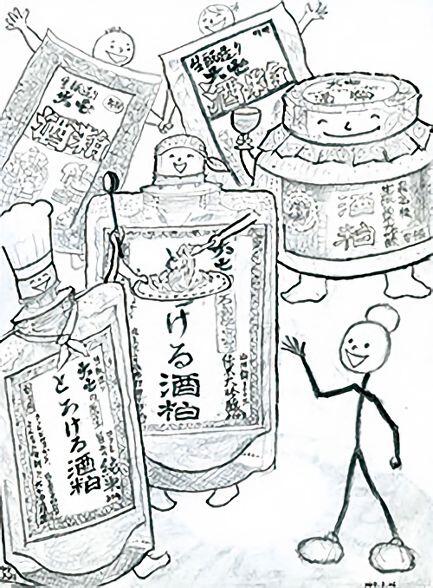| Yeast |
“In this extra edition I’m going to meet various sakekasu (sake cake, the remains of the rice after brewing). Hello, everyone!” |
| All Sakekasu together |
“Hello, Yeast.” |
| Yeast |
“We have here Itakasu (dry sakekasu), Nerikasu (soft sakekasu), Junmai Daiginjo Sakekasu in a pot with a wide opening (sakekasu made from junmai daiginjo moromi) and two kinds of Torokeru Sakekasu (melted sakekasu).” |
| Itakasu |
“Let me introduce myself first. When the sake mash (moromi) is pressed in a hydraulic press, the new sake flows out and sake cake is left behind in the boards of the press. When that is put in bags, you have itakasu. From of old it is the standard type of sakekasu. It comes on the market during the winter brewing season.” |
| Nerikasu |
“When itakasu is put for several months in a tank to mature, it becomes a viscous, delicious nerikasu through the working of enzymes. By the maturation process, it develops a rich umami and is excellent for making pickles or for use in various dishes.” |
|
 |
| Junmai Daiginjo Sakekasu (pot) |
“I am the top grade sakekasu. Junmai Daiginjo Sakekasu, made by the kimoto method from 100% Yamada Nishiki sake rice, and I have for many years been matured at low temperatures. The result is a luxurious sakekasu in a smooth paste that combines brilliance with deep umami.” |
| Junmai Torokeru Sakekasu |
“We, revolutionaries, were born last, as the brothers Torokeru Sakekasu. My elder brother is of the junmai daiginjo type, and I am junmai.” |
| Yeast |
“Wow. What is revolutionary about you?” |
| Junmai Torokeru Sakekasu |
“Firstly, we are fresh but also in smooth paste form. As we have been ground to paste in a specially made stone mortar, we dissolve quickly in food. Secondly, as we are sold in an upright plastic pack with cap, we can be used immediately after being taken out of the refrigerator. Shelf life has also been increased a lot.” |
| Junmai Daiginjo Torokeru Sakekasu |
“Let me add something. Thirdly, we have been released from the restriction of being only a wintertime ingredient. We are available the year round as healthy and delicious condiment and food ingredient.” |
| Yeast |
“I see! A regular ingredient for the kitchen at home, that is indeed revolutionary!” |
| Junmai Torokeru Sakekasu |
“We became famous through the NHK TV program ‘Tameshite Gatten,’ which announced that sakekasu contains lots of dietary fibers called ‘resistant proteins.’ These also help to reduce bad cholesterol, and are good for bowel movement.” |
| Junmai Daiginjo Torokeru Sakekasu |
“Especially because we are sakekasu made with the kimoto method, we contain traces of lactic acid that bring about even better results. Moreover, as we possess the natural umami of the kimoto method, dishes will become very delicious when a spoonful of our type of sakekasu is added. |
| Yeast |
“To what dishes do you all fit best?” |
| Itakasu |
“I’m already delicious when you only grill me in an oven toaster. You can add soy sauce or miso paste for more taste.” |
| Nerikasu |
“I’m excellent as warm soup, or for making fish fillets in sakekasu.” |
| Junmai Daiginjo Sakekasu (pot) |
“For a great snack, cut blue cheese in small cubes and add me half-and-half. You could call that ‘a love affair between East and West.’ And a famous bakery made bread by adding me to the dough. They selected me from among many other types of sakekasu, and the bread became very popular.” |
| Junmai Torokeru Sakekasu |
“I already explained that we, Torokeru Sakekasu, are very convenient in use. Use me, junmai, in dishes to which you want to add richness and umami. When used in spaghetti alla carbonara, you can leave out the eggs as I bring enough rich taste.” |
| Junmai Daiginjo Torokeru Sakekasu |
“Use me as an elegant seasoning to add a brilliant aroma and sweetness to dishes. You can also use me in desserts.” |
| Yeast |
“Thanks! Finally teach me the trick of how best to use you.” |
| All Sakekasu together |
“As we contain some alcohol, let the dish simmer for a while to cook off the alcohol when used for children. When we are stored, after time passes spots may appear on the surface. But that is alright as it is due to the crystallization of amino acids.” |





